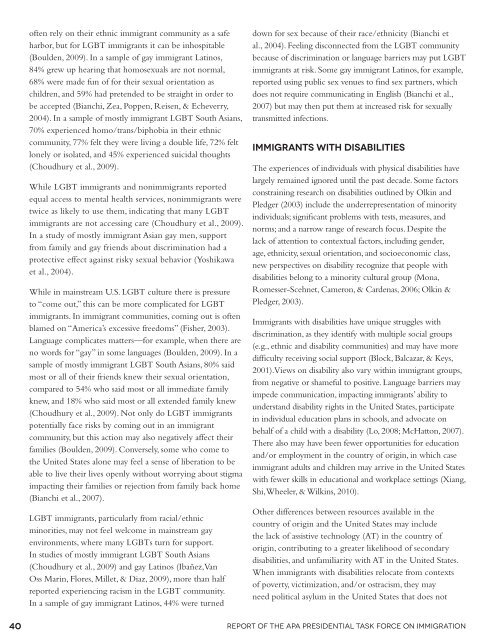Crossroads: The Psychology of Immigration in the New Century
Crossroads: The Psychology of Immigration in the New Century
Crossroads: The Psychology of Immigration in the New Century
Create successful ePaper yourself
Turn your PDF publications into a flip-book with our unique Google optimized e-Paper software.
<strong>of</strong>ten rely on <strong>the</strong>ir ethnic immigrant community as a safe<br />
harbor, but for LGBT immigrants it can be <strong>in</strong>hospitable<br />
(Boulden, 2009). In a sample <strong>of</strong> gay immigrant Lat<strong>in</strong>os,<br />
84% grew up hear<strong>in</strong>g that homosexuals are not normal,<br />
68% were made fun <strong>of</strong> for <strong>the</strong>ir sexual orientation as<br />
children, and 59% had pretended to be straight <strong>in</strong> order to<br />
be accepted (Bianchi, Zea, Poppen, Reisen, & Echeverry,<br />
2004). In a sample <strong>of</strong> mostly immigrant LGBT South Asians,<br />
70% experienced homo/trans/biphobia <strong>in</strong> <strong>the</strong>ir ethnic<br />
community, 77% felt <strong>the</strong>y were liv<strong>in</strong>g a double life, 72% felt<br />
lonely or isolated, and 45% experienced suicidal thoughts<br />
(Choudhury et al., 2009).<br />
While LGBT immigrants and nonimmigrants reported<br />
equal access to mental health services, nonimmigrants were<br />
twice as likely to use <strong>the</strong>m, <strong>in</strong>dicat<strong>in</strong>g that many LGBT<br />
immigrants are not access<strong>in</strong>g care (Choudhury et al., 2009).<br />
In a study <strong>of</strong> mostly immigrant Asian gay men, support<br />
from family and gay friends about discrim<strong>in</strong>ation had a<br />
protective effect aga<strong>in</strong>st risky sexual behavior (Yoshikawa<br />
et al., 2004).<br />
While <strong>in</strong> ma<strong>in</strong>stream U.S. LGBT culture <strong>the</strong>re is pressure<br />
to “come out,” this can be more complicated for LGBT<br />
immigrants. In immigrant communities, com<strong>in</strong>g out is <strong>of</strong>ten<br />
blamed on “America’s excessive freedoms” (Fisher, 2003).<br />
Language complicates matters—for example, when <strong>the</strong>re are<br />
no words for “gay” <strong>in</strong> some languages (Boulden, 2009). In a<br />
sample <strong>of</strong> mostly immigrant LGBT South Asians, 80% said<br />
most or all <strong>of</strong> <strong>the</strong>ir friends knew <strong>the</strong>ir sexual orientation,<br />
compared to 54% who said most or all immediate family<br />
knew, and 18% who said most or all extended family knew<br />
(Choudhury et al., 2009). Not only do LGBT immigrants<br />
potentially face risks by com<strong>in</strong>g out <strong>in</strong> an immigrant<br />
community, but this action may also negatively affect <strong>the</strong>ir<br />
families (Boulden, 2009). Conversely, some who come to<br />
<strong>the</strong> United States alone may feel a sense <strong>of</strong> liberation to be<br />
able to live <strong>the</strong>ir lives openly without worry<strong>in</strong>g about stigma<br />
impact<strong>in</strong>g <strong>the</strong>ir families or rejection from family back home<br />
(Bianchi et al., 2007).<br />
LGBT immigrants, particularly from racial/ethnic<br />
m<strong>in</strong>orities, may not feel welcome <strong>in</strong> ma<strong>in</strong>stream gay<br />
environments, where many LGBTs turn for support.<br />
In studies <strong>of</strong> mostly immigrant LGBT South Asians<br />
(Choudhury et al., 2009) and gay Lat<strong>in</strong>os (Ibañez, Van<br />
Oss Mar<strong>in</strong>, Flores, Millet, & Diaz, 2009), more than half<br />
reported experienc<strong>in</strong>g racism <strong>in</strong> <strong>the</strong> LGBT community.<br />
In a sample <strong>of</strong> gay immigrant Lat<strong>in</strong>os, 44% were turned<br />
down for sex because <strong>of</strong> <strong>the</strong>ir race/ethnicity (Bianchi et<br />
al., 2004). Feel<strong>in</strong>g disconnected from <strong>the</strong> LGBT community<br />
because <strong>of</strong> discrim<strong>in</strong>ation or language barriers may put LGBT<br />
immigrants at risk. Some gay immigrant Lat<strong>in</strong>os, for example,<br />
reported us<strong>in</strong>g public sex venues to f<strong>in</strong>d sex partners, which<br />
does not require communicat<strong>in</strong>g <strong>in</strong> English (Bianchi et al.,<br />
2007) but may <strong>the</strong>n put <strong>the</strong>m at <strong>in</strong>creased risk for sexually<br />
transmitted <strong>in</strong>fections.<br />
Immigrants With disabilities<br />
<strong>The</strong> experiences <strong>of</strong> <strong>in</strong>dividuals with physical disabilities have<br />
largely rema<strong>in</strong>ed ignored until <strong>the</strong> past decade. Some factors<br />
constra<strong>in</strong><strong>in</strong>g research on disabilities outl<strong>in</strong>ed by Olk<strong>in</strong> and<br />
Pledger (2003) <strong>in</strong>clude <strong>the</strong> underrepresentation <strong>of</strong> m<strong>in</strong>ority<br />
<strong>in</strong>dividuals; significant problems with tests, measures, and<br />
norms; and a narrow range <strong>of</strong> research focus. Despite <strong>the</strong><br />
lack <strong>of</strong> attention to contextual factors, <strong>in</strong>clud<strong>in</strong>g gender,<br />
age, ethnicity, sexual orientation, and socioeconomic class,<br />
new perspectives on disability recognize that people with<br />
disabilities belong to a m<strong>in</strong>ority cultural group (Mona,<br />
Romesser-Scehnet, Cameron, & Cardenas, 2006; Olk<strong>in</strong> &<br />
Pledger, 2003).<br />
Immigrants with disabilities have unique struggles with<br />
discrim<strong>in</strong>ation, as <strong>the</strong>y identify with multiple social groups<br />
(e.g., ethnic and disability communities) and may have more<br />
difficulty receiv<strong>in</strong>g social support (Block, Balcazar, & Keys,<br />
2001). Views on disability also vary with<strong>in</strong> immigrant groups,<br />
from negative or shameful to positive. Language barriers may<br />
impede communication, impact<strong>in</strong>g immigrants’ ability to<br />
understand disability rights <strong>in</strong> <strong>the</strong> United States, participate<br />
<strong>in</strong> <strong>in</strong>dividual education plans <strong>in</strong> schools, and advocate on<br />
behalf <strong>of</strong> a child with a disability (Lo, 2008; McHatton, 2007).<br />
<strong>The</strong>re also may have been fewer opportunities for education<br />
and/or employment <strong>in</strong> <strong>the</strong> country <strong>of</strong> orig<strong>in</strong>, <strong>in</strong> which case<br />
immigrant adults and children may arrive <strong>in</strong> <strong>the</strong> United States<br />
with fewer skills <strong>in</strong> educational and workplace sett<strong>in</strong>gs (Xiang,<br />
Shi, Wheeler, & Wilk<strong>in</strong>s, 2010).<br />
O<strong>the</strong>r differences between resources available <strong>in</strong> <strong>the</strong><br />
country <strong>of</strong> orig<strong>in</strong> and <strong>the</strong> United States may <strong>in</strong>clude<br />
<strong>the</strong> lack <strong>of</strong> assistive technology (AT) <strong>in</strong> <strong>the</strong> country <strong>of</strong><br />
orig<strong>in</strong>, contribut<strong>in</strong>g to a greater likelihood <strong>of</strong> secondary<br />
disabilities, and unfamiliarity with AT <strong>in</strong> <strong>the</strong> United States.<br />
When immigrants with disabilities relocate from contexts<br />
<strong>of</strong> poverty, victimization, and/or ostracism, <strong>the</strong>y may<br />
need political asylum <strong>in</strong> <strong>the</strong> United States that does not<br />
40 Report <strong>of</strong> <strong>the</strong> APA Presidential Task Force on <strong>Immigration</strong>
















